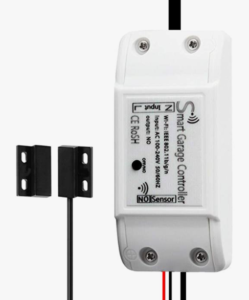
Alert reader Mike mentioned an internet-connected garage door trigger (see comment to previous blog article). He’s right. These triggers are very handy. And they only cost $30.
The one that I use, made by a company called “Moes”, is not available on Amazon any more. Here (Amazon) you can see one that looks very similar. I will describe how this works.
You start by figuring out whether you can even use this thing. The question is, is your garage door opener the nice kind that triggers by touching two wires together? Can you trigger it with an ordinary SPST pushbutton? Or is your garage door opener the nasty kind that uses a proprietary signaling protocol and at the other end of two wires is a seemingly simple push-button switch but it is actually a controller with a circuit board inside and a lot of proprietary circuitry? If the latter, then you will have to attack the seemingly simple push-button switch with a soldering iron and bring out two wires from the contacts of the SPST switch that is inside that controller. Touching those two wires together will trigger the garage door, if you did the soldering correctly.
Having worked out how to trigger your garage door with an SPST momentary connection, you order up this controller on Amazon. You mount the magnet on the top edge of your garage door. You mount the reed switch on the door sill, close by to the magnet location when the garage door is closed. You staple a two-wire reed switch cable from that location to where the garage door opener is located. You mount this white box nearby to the garage door opener and connect it electrically to the aforementioned reed switch cable. There are two wires coming out of this white box, which are normally-open “dry-relay” contacts. This is what is going to trigger your garage door. Maybe this means you have to run a two-wire cable down to that proprietary controller by the garage entrance person-door, if your garage door opener is the nasty kind. Or maybe you just run these two dry-relay wires to the matching two terminals on the garage door opener if it is the nice kind.
The remaining connection is that you plug this white box into AC power. That is easy, because of course the garage door opener is plugged into a duplex receptacle, and one of the two receptacles has been vacant for all these years. Now for the first time in all these years, both receptacles are in use.
The next step is to introduce the white box to the 2.4-gigahertz wifi network in your house. Oh yes I forgot to mention this whole thing only works if the garage location has decent connectivity to some sort of 2.4-gigahertz wifi network.
To do this you have to “create an account” in some app that is connected to a cloud somewhere. Whenever this sort of thing arises I always set up a specialized email forward that is dedicated to the particular cloud involved, and I always disclose the absolute minimum amount of information that I can get away with. Where is the cloud? Who knows? China probably. I try not to think about it.
What a smart person will do is set up a special VLAN on their network, that does not connect to anything except the outside world, and that especially does not connect to any local resources. And this special VLAN gets tied to a special wifi SSID around the house that is dedicated to all of the internet-of-things devices that are lurking around the house. The idea being that if one of the IOT devices goes rogue, there will be a limit to how much harm it can cause.
Then it is the usual fuss and bother to configure the IOT device. You push a button on the white box continuously until a blue light blinks very fast. This means the white box is now offering its own ephemeral wifi hot spot. You look for this ephemeral wifi hot spot with your app, and the app finds the white box’s ephemeral wifi hot spot. You then tell the white box how to connect to your local wifi. Eventually after five or six tries, you spell the wifi password correctly and you successfully teach it to the white box, and it successfully registers to the wifi hot spot, and the blue light becomes a steady blue. The app goes back to connecting to the normal wifi in your house, and the app announces that the white box is “online”.
So once the white box learns how to connect to the wifi SSID, then of course the white box runs off and registers to that cloud wherever it is.
Generally what happens next is that the white box discovers that it is way out of date in terms of firmware, and some time passes while one or two firmware updates take place. Eventually things are up to date.
At that point, you can click around in the app and you can see whether the garage door is open or closed. You can open it and you can close it. You can get an alert every time it opens. You can get an extra alert if it stays open too long.
